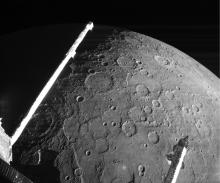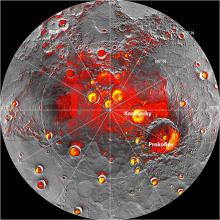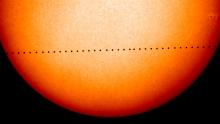Listen to today's episode of StarDate on the web the same day it airs in high-quality streaming audio without any extra ads or announcements. Choose a $8 one-month pass, or listen every day for a year for just $30.
You are here
Morning Mercury
Mercury is putting in a pretty good appearance in the dawn sky. The planet is low in the east-southeast in the early glow of twilight, and looks like a bright star. The star Spica is close to its upper right, with much brighter Venus, the “morning star,” standing high above them.
Mercury is the closest planet to the Sun, so you might expect it to be the hottest planet as well — but it’s not. Venus is hotter. It has a thick atmosphere that traps the Sun’s heat. So temperatures are high enough to melt lead across the entire planet.
Instead, Mercury has the most extreme changes in temperature. And that takes a toll on the surface of the little planet.
Mercury has no atmosphere, so there’s nothing to block the Sun’s intense radiation. So noontime temperatures at the equator can top out at 800 degrees Fahrenheit. And Mercury rotates very slowly, so any point near the equator stays hot for weeks.
But since there’s no air to retain that heat, as a spot finally rotates over to Mercury’s nightside it gets cold — as low as 300 below.
That constant cycle of hot and cold causes Mercury’s surface to expand and contract. Over the eons, that’s cracked and pulverized some of its rocks.
Incidentally, not every spot on Mercury gets hot. Some craters at the north pole are so deep that sunlight never reaches their floors. So some of those craters hold large deposits of ice — perpetual cold spots on a hot-and-cold planet.
Script by Damond Benningfield





